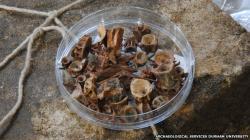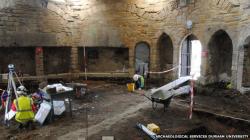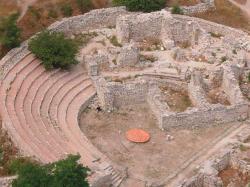INSTITUT SUPERIEUR D'ANTHROPOLOGIE
INSTITUTE OF ANTHROPOLOGY
ONLINE COURSES / COURS A DISTANCE
SUMMER TERM : JULY 2014
REGISTER NOW
INDONESIE - Ngreco - The National Archeological Excavation Center has found more evidence of the existence of the Sailendra civilization, believed to have prospered during the 7th century in Ngreco hamlet, Kesongo village, Tuntang district, Semarang regency, Central Java. Previously, a team found pieces of bricks, artifacts and a jaladwara waterway segment, while recently it discovered a foundation believed to have been used for a temple structure. A jaladwara was a water sewage system commonly found in bath houses during ancient times. The tip of the jaladwara is usually the shape of a dragon’s head. The finding is strengthened by the discovery of soil that is harder than that in other locations.“However, the direction and land of the temple structure still remains unclear,” said National Archeological Excavation Center team leader Indrajaya Agustijanto on Tuesday. Based on evidence, he said the structure’s foundation was longer than 3.6 meters and was made of brick. According to Indrajaya, the findings in Tuntang district are part of efforts to gather knowledge on culture during the Sailendra kingdom era. The research took place in Tegal, Pekalongan, Batang and Semarang regencies. “During a two-week exploration in the Gringsing area of Batang, archeologists found a waterway system and a passage to the Dieng plateau,” said Indrajaya. The excavation in Tuntang stemmed from a discovery of a plaque located not far from the current excavation site. The plaque, etched with the number “685” of the Saka era, or around the 7th century, showed the presence of an ancient civilization in Ngreco. The team of archeologists then conducted further studies to make sure the artifacts in Ngreco dated back to the 7th century.He added the discovery of the jaladwara in Ngreco hamlet suggested the presence of a waterway. By far the oldest known inscription is the Canggal plaque in Magelang, also in Central Java, dating back to 732 AD. “When compared to the Canggal plaque in Magelang, the time span is between 20 and 40 years, so it can be said that the finding in Ngreco is quite old when associated with the Sailendra period,” Indrajaya went on. The Sailendra dynasty was founded in 752 AD by King Bhanu with the influence of the Buddha Mahayana. One of its greatest legacies is the Borobudur temple complex in Magelang. The dynasty was successful in expanding its territory to Cambodia, but it collapsed in 850 AD.
http://www.thejakartapost.com/news/2014/04/09/remnants-sailendra-dynasty-allegedly-found.html
ITALIE –  Rome - It is already known as the eternal city, and if new archeological findings prove correct Rome may turn out to be even more so than believed until now. Next week, the city will celebrate its official, 2,767th birthday. According to a tradition going back to classic times, the brothers Romulus and Remus founded the city on 21 April in the year 753BC. But on Sundayit was reported that evidence of infrastructure building had been found, dating from more than 100 years earlier. The daily Il Messagero quoted Patrizia Fortini, the archaeologist responsible for the Forum, as saying that a wall constructed well before the city's traditional founding date had been unearthed. The wall, made from blocks of volcanic tuff, appeared to have been built to channel water from an aquifer under the Capitoline hill that flows into the river Spino, a tributary of the Tiber. Around the wall, archaeologists found pieces of ceramic pottery and remains of food. "The examination of the ceramic material was crucial, allowing us today to fix the wall chronologically between the 9th century and the beginning of the 8th century," said Fortini. It was already known that the settlement of Rome was a gradual process and that the traditional date for its foundation was invented by a later writer. There is evidence of people arriving on the Palatine hill as early as the 10th century BC. The find would appear to show that construction in stone began earlier than previously established. The discovery was made close to the Lapis Niger ('Black Stone' in Latin): a shrine that later Romans associated with their city's earliest days. The site includes a stone block that carries the earliest inscription found in Rome. Written in the 5th century BC, its meaning is not fully clear, but it is thought to place a curse on anyone who violates the site.
Rome - It is already known as the eternal city, and if new archeological findings prove correct Rome may turn out to be even more so than believed until now. Next week, the city will celebrate its official, 2,767th birthday. According to a tradition going back to classic times, the brothers Romulus and Remus founded the city on 21 April in the year 753BC. But on Sundayit was reported that evidence of infrastructure building had been found, dating from more than 100 years earlier. The daily Il Messagero quoted Patrizia Fortini, the archaeologist responsible for the Forum, as saying that a wall constructed well before the city's traditional founding date had been unearthed. The wall, made from blocks of volcanic tuff, appeared to have been built to channel water from an aquifer under the Capitoline hill that flows into the river Spino, a tributary of the Tiber. Around the wall, archaeologists found pieces of ceramic pottery and remains of food. "The examination of the ceramic material was crucial, allowing us today to fix the wall chronologically between the 9th century and the beginning of the 8th century," said Fortini. It was already known that the settlement of Rome was a gradual process and that the traditional date for its foundation was invented by a later writer. There is evidence of people arriving on the Palatine hill as early as the 10th century BC. The find would appear to show that construction in stone began earlier than previously established. The discovery was made close to the Lapis Niger ('Black Stone' in Latin): a shrine that later Romans associated with their city's earliest days. The site includes a stone block that carries the earliest inscription found in Rome. Written in the 5th century BC, its meaning is not fully clear, but it is thought to place a curse on anyone who violates the site.
http://www.theguardian.com/world/2014/apr/13/archaelogists-find-rome-century-older-than-thought?
ROYAUME UNI –  Maryport - The second excavation of a Maryport Roman site has begun.Archaeologists want to find out more about a building discovered last year which appeared to have been a shop and living accommodation.The dig will go into the back yard of this and the remains of other properties. Mr Zant said it was hoped to dig below an existing layer of excavation to establish how long there had been a settlement on the site which could support evidence that there was a second fort in Maryport earlier than the one built around AD 120.
Maryport - The second excavation of a Maryport Roman site has begun.Archaeologists want to find out more about a building discovered last year which appeared to have been a shop and living accommodation.The dig will go into the back yard of this and the remains of other properties. Mr Zant said it was hoped to dig below an existing layer of excavation to establish how long there had been a settlement on the site which could support evidence that there was a second fort in Maryport earlier than the one built around AD 120.
http://www.timesandstar.co.uk/news/people/new-roman-dig-starts-in-maryport-1.1129297
ROYAUME UNI –  York – An archaeological dig has started at a medieval church in York City-centre in the hope of finding medieval, Viking and Roman artefacts.The dig at the Church of All Saints in North Street will continue in phases until October. Evidence of Roman life has previously been found at the church, which is known for its history. Church Warden Dr Robert Richards has said that the site was home to a medieval rectory and that an 18th-century floor had already been uncovered there.
York – An archaeological dig has started at a medieval church in York City-centre in the hope of finding medieval, Viking and Roman artefacts.The dig at the Church of All Saints in North Street will continue in phases until October. Evidence of Roman life has previously been found at the church, which is known for its history. Church Warden Dr Robert Richards has said that the site was home to a medieval rectory and that an 18th-century floor had already been uncovered there.
http://www.yorkpress.co.uk/news/11142631.Archaeological_dig_underway_at_city_centre_church/
ROYAUME UNI – 
 Durham - More than 20,000 animal bones have been unearthed during an excavation at Durham Cathedral. The bones of fish and birds were among a "massive amount" of food waste found in the area of the cathedral's 14th Century kitchen. Archaeologist Norman Emery said they gave a "unique insight" into the diet of monks who lived at the cathedral.Mr Emery, the cathedral's resident archaeologist, said: "All the animal bones, birds, fish, they are really well preserved, all the way down to the scales off the fish. "You can see the butchers marks and even how they were cooked and processed - you can tell what angle the knife was at and at how many degrees, it's like forensic science." The Open Treasure project has seen the excavation of a major area on the ground floor of the cathedral from the cloister into the great kitchen, believed to be one of only two intact surviving monastic kitchens in England.The Durham University team dug a 1m sq test pit before the full excavation and found 21,000 discarded animal bones. From identifying the samples, they were able to pin the bones down to each species, including deep sea fish such as turbot and sole, to some freshwater fish probably from the River Wear like salmon and trout."[The monks] ate just about everything," Mr Emery said. "There's records of them eating domestic and wild birds from surrounding estuaries, to migratory birds and birds from the coast including puffins from the Farnes on rare occasions."
Durham - More than 20,000 animal bones have been unearthed during an excavation at Durham Cathedral. The bones of fish and birds were among a "massive amount" of food waste found in the area of the cathedral's 14th Century kitchen. Archaeologist Norman Emery said they gave a "unique insight" into the diet of monks who lived at the cathedral.Mr Emery, the cathedral's resident archaeologist, said: "All the animal bones, birds, fish, they are really well preserved, all the way down to the scales off the fish. "You can see the butchers marks and even how they were cooked and processed - you can tell what angle the knife was at and at how many degrees, it's like forensic science." The Open Treasure project has seen the excavation of a major area on the ground floor of the cathedral from the cloister into the great kitchen, believed to be one of only two intact surviving monastic kitchens in England.The Durham University team dug a 1m sq test pit before the full excavation and found 21,000 discarded animal bones. From identifying the samples, they were able to pin the bones down to each species, including deep sea fish such as turbot and sole, to some freshwater fish probably from the River Wear like salmon and trout."[The monks] ate just about everything," Mr Emery said. "There's records of them eating domestic and wild birds from surrounding estuaries, to migratory birds and birds from the coast including puffins from the Farnes on rare occasions."
http://www.bbc.com/news/uk-england-tyne-26953378?
USA – Minnesota - For 46 years, a canoe thought to date to the 1700s sat in the back of a display case as a minor exhibit at a small museum run by a volunteer historical group in Minnesota. But this week, archaeologists who conducted radio carbon tests on the canoe said it was crafted almost 1,000 years ago, making it the oldest canoe in the state and shedding light on early navigation of Minnesota lakes.The dugout canoe was hollowed out of a single large tree, said Ann Merriman, nautical archaeologist for Maritime Heritage Minnesota, which researched the age of the canoe and seven others as part of a Maritime History Minnesota project. Indians made dugout canoes by first burning out the center of a felled tree trunk and then carving the inside, she said. The canoe was found in 1934 buried in mud in Lake Minnetonka, a large body of water in suburban Minneapolis, by a family building a dock, Ferrin said.Archaeologists estimated the canoe was made between 1025 and 1165. Dugout canoes as old as 5,000 years have been found in the southeastern United States, but the Minnesota canoe may be the most significant nautical find in the state's history because of how well it was crafted and preserved, Merriman said.
https://au.news.yahoo.com/thewest/offbeat/a/22561716/?
INDONESIE - Semarang - Underwater drones may have successfully found the 16tcenturyPortuguese vessel Flor De La Mar, which is believed to have sailed from Malacca with stolen treasure from the sultanate when it sank. At least two underwater salvage companies have claimed that the galleon that sank during a storm circa 1512 has been sighted in Java Sea, close to Semarang in Indonesia. They are basing their claims on images beamed by the drones. Underwater drones are commonly used by petroleum companies. The galleon was reportedly laden with stolen treasure from the Malaccan sultanate, including 60 tonnes of gold, now worth billions of ringgit. Chief Minister Datuk Seri Idris Haron said he had not received any official confirmation “but only unsubstantiated reports claiming that the shipwreck has been located”. “We have been hearing speculation and theories, but this time we hope it’s true,” he said on Saturday. Idris said the state government would put forward its claim if the documents on the discovery were confirmed by the Indonesian government. “We would request for royalty from the salvaged treasures through cordial bilateral channels. “This is in accordance with the historical fact that the galleon was carrying stolen treasure from the Malacca kingdom,” he said. Flor De La Mar (Flower of the Sea) was built in Lisbon in 1502 and the galleon’s maiden voyage was to Goa, India, in 1505. It was used in the conquests of Ormuz (Persian Gulf) in 1507, Goa in 1510 and Malacca in 1511, as well as the Battle of Diu (India) in 1509. The vessel is said to have sunk during bad weather in the Strait of Malacca while on a return trip to Lisbon with Alfonso de Albuquerque stewarding it. Based on Portuguese annals, Flor De La Mar was also carrying jewellery and precious stones. Among the artefacts were two lion-shaped brass oil lamps and a magical bracelet of the Maharajah of Shahbandar.
http://www.thestar.com.my/News/Nation/2014/04/07/Drones-may-have-found-treasure-ship-Sunken-Portuguese-galleon-sighted-in-Java-Sea/
UKRAINE –  Chersonèse Taurique - L’Unesco a pris acte d’un appel de l’Ukraine dénonçant «un transfert massif d’objets culturels inestimables des musées» vers Moscou par les forces russes. Dans le même temps Bouclier Bleu, une association internationale pour la protection du patrimoine dans les conflits, a averti du «danger de pillage et de destruction»dans le pays. Une résolution exprimant la «profonde préoccupation» de l’agence des Nations unies chargée de la culture devant la «mise en danger du patrimoine de la Crimée» a été adoptée jeudi par le conseil exécutif réuni à Paris. Ce point a été ajouté à l’ordre du jour à la demande de l’Ukraine, avec l’appui du Royaume Uni, en dépit de la violente opposition de la délégation russe. La motion fait aussi état des périls pesant sur les sites archéologiques, telle la cité antique de Chersonèse Taurique, près de Sébastopol où est stationnée la flotte russe. A ce stade, l’Unesco n’a pas encore arrêté les mesures d’urgence qu’elle pourrait prendre, mais sa directrice générale, Irina Bokova doit se rendre prochainement en Ukraine.
Chersonèse Taurique - L’Unesco a pris acte d’un appel de l’Ukraine dénonçant «un transfert massif d’objets culturels inestimables des musées» vers Moscou par les forces russes. Dans le même temps Bouclier Bleu, une association internationale pour la protection du patrimoine dans les conflits, a averti du «danger de pillage et de destruction»dans le pays. Une résolution exprimant la «profonde préoccupation» de l’agence des Nations unies chargée de la culture devant la «mise en danger du patrimoine de la Crimée» a été adoptée jeudi par le conseil exécutif réuni à Paris. Ce point a été ajouté à l’ordre du jour à la demande de l’Ukraine, avec l’appui du Royaume Uni, en dépit de la violente opposition de la délégation russe. La motion fait aussi état des périls pesant sur les sites archéologiques, telle la cité antique de Chersonèse Taurique, près de Sébastopol où est stationnée la flotte russe. A ce stade, l’Unesco n’a pas encore arrêté les mesures d’urgence qu’elle pourrait prendre, mais sa directrice générale, Irina Bokova doit se rendre prochainement en Ukraine.
https://fr.news.yahoo.com/lunesco-sinqui%C3%A8te-dun-pillage-culture-ukrainienne-russie-082351566.html